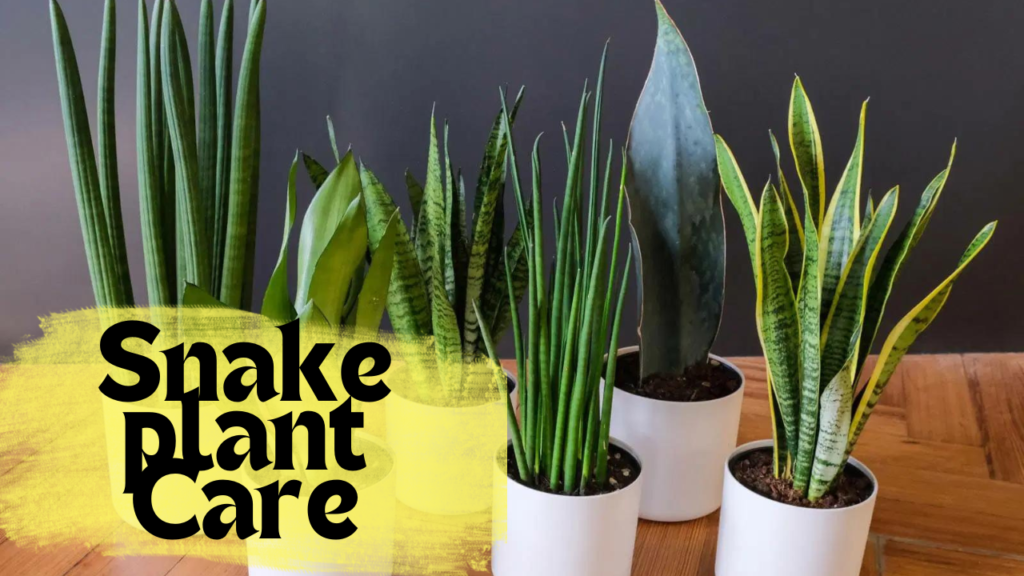Grow and Care for Snake Plants: Propagation, Pests, Treatments, Common Issues
Snake plants, scientifically known as Sansevieria, have earned their place as one of the most beloved indoor plants. With their striking appearance and low-maintenance care requirements, these hardy houseplants have become a staple in homes and offices around the world. In this comprehensive guide, we will delve into everything you need to know about snake plants, from care guidelines to their numerous benefits and some lesser-known facts.
In this guide, we’ll cover the basics of snake plant care, including propagation methods, pests and treatments, and common issues you may encounter. With this knowledge, you’ll be able to expand your snake plant collection and maintain beautiful, healthy plants for years to come.

Key Takeaways
- Snake plants are hardy and striking indoor plants that are easy to care for.
- Snake plants offer numerous benefits, including improving air quality and adding elegance to your home.
- Choosing the right snake plant type is important to ensure optimal growth and health.
How to care for snake plant indoor Guidelines
Snake plants (Sansevieria) are one of the easiest and most popular houseplants to care for. They are known for their drought-tolerance and low-maintenance requirements, making them a great choice for busy people or those who are new to plant care:
Here are the basic snake plant care guidelines:
- Watering: Snake plants only need to be watered when the soil is completely dry. Overwatering is the most common cause of death in snake plants, so it is important to be careful not to water too often.
- Light: Snake plants can tolerate a wide range of light conditions, but they prefer bright, indirect sunlight. Excessive direct sunlight can cause the leaves to become scorched.
- Soil: Snake plants prefer a well-draining potting mix. A cactus mix or a general potting mix with added perlite or sand will work well.
- Fertilizer: Snake plants thrive with monthly spring/summer fertilization using balanced, water-soluble fertilizer; avoid overdoing it to prevent harm. No winter feeding.
- Humidity: Snake plants are tolerant of low humidity levels. However, they will benefit from being misted occasionally, especially during the winter months.
- Repot every two to three years: As snake plants grow, they will need to be repotted into a larger pot. Select a pot that is just one size larger than the current one.
- Prune as needed: Snake plants can be pruned to control their size and shape. Simply cut off any leaves that are damaged or dead.
- Clean the leaves: Snake plant leaves can collect dust and debris. Clean and shine the leaves by wiping them with a damp cloth.
By considering these factors and selecting a snake plant type that meets your needs, you’ll be well on your way to becoming a successful snake plant owner.
Types of Snake Plant
Snake plants come in a variety of shapes, sizes, and patterns, so it’s essential to know what you’re looking for before making a selection. Each has its own unique characteristics. Some of the most popular types of snake plants include:
- Sansevieria trifasciata ‘Laurentii’: This is the most common type of snake plant. It has long, sword-shaped leaves with yellow margins.
- Sansevieria trifasciata ‘Golden Hahnii’: This type of snake plant has short, thick leaves with golden yellow stripes.
- Sansevieria trifasciata ‘Moonshine’: This type of snake plant has light green leaves with white stripes.
- Sansevieria cylindrica: This type of snake plant has cylindrical leaves that grow upright.
- Sansevieria masoniana ‘Twister’: This type of snake plant has twisted leaves that grow in a spiral pattern.
When choosing a snake plant, consider the size and shape of your space. If you have a small area, a compact variety like the Sansevieria cylindrica might be more suitable. If you have a larger area, a taller variety like the Sansevieria laurentii might work better.
Propagating Snake Plants: A Step-by-Step Guide
If you’re looking to expand your snake plant collection, propagating them is a cost-effective way to do so. Here’s a step-by-step guide on how to propagate snake plants. Snake plants can be propagated from leaf cuttings, Division, or from seed.
Method 1: To propagate from leaf cuttings:
The first method is through leaf cuttings:
- Find a healthy leaf on your snake plant.
- Use a clean pair of scissors or pruning shears to cut the leaf as close to the soil as possible.
- Cut the leaf into several sections, each around 3-4 inches long.
- Leave the cuttings to dry for a few days, until the cut ends have calloused over.
- Plant the cuttings vertically, and cut the end down, in a well-draining potting mix.
- Water the cuttings regularly, keeping the soil moist but not waterlogged.
- After a few weeks, new growth should appear from the base of the cuttings.
Method 2: Division
The second method is by dividing the plant:
- Remove the snake plant from its pot and gently loosen the soil around the roots.
- Identify any offshoots or pups that have grown from the main plant.
- Carefully separate the pup from the parent plant, ensuring it has its own intact root system.
- Plant the pup in a well-draining potting mix in a separate pot.
- Water the new plant regularly, keeping the soil consistently moist.
- After a few weeks, new growth should appear in the pup.
Method 3: How to Grow Snake Plant From Seed
- Sow the seeds in a well-draining potting mix.
- Keep the soil moist but not wet.
- Seeds should germinate in 2-4 weeks.
- Once the seedlings have developed a few leaves, you can move them into separate pots.
With these simple steps, you’ll soon have plenty of new snake plants to add to your collection.
Potting and Repotting Snake Plant
Repotting snake plants is an essential part of their care routine. It ensures that they have enough space to grow and develop healthy root systems or Snake plants should be repotted every two to three years. But when is the best time to repot your snake plant, and how should you go about it?
The ideal time to repot snake plants is during their active growth period, which occurs in the spring and summer months. You can check if your plant needs repotting by gently removing it from its existing pot and inspecting the roots. If they are densely packed, it’s time for a new pot.
Snake Plant Overwintering indoors or outdoors
Snake plants can be overwintered indoors or outdoors. If overwintering indoors, place the plant in a cool, bright location. Reduce the frequency of watering during the winter months. If overwintering outdoors, place the plant in a sheltered spot where it will not get too cold.
6 Benefits of Snake Plants Keeping In Home
Snake plants come in a variety of shapes, sizes, and patterns, so it’s essential to know what you’re looking for before making a selection. Snake plants have many benefits, both for your home and for your health. Here are a few of the benefits of snake plants:
- Air purification: Snake plants are known for their ability to purify the air. They remove toxins such as formaldehyde, benzene, and trichloroethylene from the air, making them a great choice of plant for homes with poor air quality.
- Reduced stress: Snake plants have been shown to reduce stress and anxiety. Studies have shown that people who spend time in rooms with snake plants have lower heart rates and blood pressure levels.
- Improved sleep: Snake plants also improve sleep quality. They release oxygen during the night, potentially aiding in improving your sleep.
- Increased humidity: Snake plants can help to increase humidity levels in your home. This is beneficial for people with dry skin or respiratory problems.
- Decorative value: Snake plants are also very attractive plants. They have long, sword-shaped leaves that come in a variety of colors and patterns. They can be grown in pots or planted in the ground. Snake plants come in various shapes and sizes, making them versatile decorative elements for any space.
- Low Maintenance: They require minimal care, making them perfect for beginners or those with busy lifestyles.
Disadvantages of Snake Plant
Snake plants are generally very low-maintenance plants, but there are a few potential disadvantages to consider:
- They can be poisonous to pets and children if ingested.
- The sap from the leaves can irritate the skin of some people.
- They can grow quite large, so they may not be suitable for small spaces.
Common Pests: Prevention and Control
If you’re new to snake plant care, it’s essential to know that these plants are generally quite hardy and resistant to pests and diseases. However, some pests can still cause problems if you don’t take proper care. Here are some of the most common pests that can affect snake plants:
- Spider mites: These tiny arachnids are a common problem for indoor plants, and snake plants are no exception. They typically appear as tiny red or brown spots on the leaves and can cause significant damage if not treated promptly.
- Mealybugs: These small, white insects are another common pest that can infest snake plants. They’re often found in clusters near the base of the leaves and can cause yellowing and wilting.
- Scale insects: These small, circular insects are typically found on the undersides of leaves and can cause yellowing, wilting, and leaf drop.
To prevent these pests from infesting your snake plants, it’s crucial to maintain a clean and healthy environment. Here are some prevention and control methods:
- Inspect your plants regularly: Be sure to check your plants for any signs of pests on a regular basis. Inspect the leaves, stems, and soil and look for any unusual spots, discoloration, or webbing.
- Isolate infected plants: If you find any signs of pest infestation, immediately separate the affected plant and place it away from other plants. This will help prevent the infestation from spreading.
- Use insecticidal soap: If your plant is infested with pests, you can use insecticidal soap to control the problem. Apply the soap to the affected areas and rinse with water after a few hours.
- Wipe leaves: Wiping the leaves of your plants with a damp cloth can also help control insect populations. This method removes insects, eggs, and webbing, reducing the number of pests on your plant.
By following these prevention and control methods, you can keep your snake plants healthy and pest-free. Remember, prevention is always better than cure, so be sure to maintain good care practices and inspect your plants regularly.
Treating Snake Plant Issues
Despite your best efforts, you may encounter some issues with your snake plants. Here are some common problems and their solutions:
Browning leaf tips
If you notice brown tips on the leaves of your snake plant, it may be due to underwatering or dry air. Try watering your plant more frequently and placing a humidifier nearby. You can also mist the leaves with water to increase humidity levels.
Yellowing leaves
Yellowing leaves can indicate overwatering or root rot. Check the soil moisture level and reduce watering if necessary. If the roots are rotting, you may need to repot the plant and remove any damaged roots.
Soft or mushy leaves
Soft or mushy leaves can be a sign of overwatering or bacterial infection. Allow the soil to dry out before watering again and avoid getting water on the leaves. If the issue persists, you may need to remove the affected leaves and treat the plant with a fungicide.
Stunted growth
If your snake plant isn’t growing as fast as you’d like, it may be due to a lack of light or nutrients. Ensure your plant is getting enough bright, indirect light, and consider fertilizing with a balanced houseplant fertilizer every 2-4 weeks during the growing season.
Pests
| Pest | Symptoms | Treatment |
|---|---|---|
| Spider mites | Webbing, tiny spots on leaves | Wipe leaves with a damp cloth and apply insecticidal soap |
| Mealybugs | White, cotton-like masses on leaves | Remove by hand and apply insecticidal soap |
| Scale insects | Small, raised bumps on leaves | Remove by hand and apply horticultural oil |
Prevention is key when it comes to pest control. Regularly inspect your snake plant for signs of pests and isolate any infected plants. Avoid overwatering and overcrowding plants, which can attract pests.
Are snake plants hard to keep alive?
Not at all! Snake plants are considered one of the easiest houseplants to care for due to their low maintenance and low light requirement plant.
Where is the best place to put a snake plant?
Snake plants can be placed in a variety of locations in your home. They are a good choice for low-light areas, such as a hallway or bathroom. They can also be placed in bright, indirect sunlight, such as a window sill.
Is it OK to sleep with a snake plant?
Yes, it is okay to sleep with a snake plant in your bedroom. Snake plants release oxygen at night, which can help you sleep better. However, it is important to keep the plant out of reach of children and pets, as the sap can be poisonous.
Are snake plants toxic to touch for humans or pets?
Yes, snake plants are toxic to touch for both humans and pets. The sap from the leaves can cause skin irritation and, if ingested, can lead to vomiting, diarrhea, and other symptoms. If you or your pet come into contact with the sap, wash the affected area immediately with soap and water.
Why are my snake plant’s leaves turning yellow or leaves tips turning brown?
Yellowing leaves in snake plants can be caused by various factors, including overwatering, root rot, pest infestations, or inadequate lighting. To determine the cause, check the soil moisture, examine the roots, and ensure the plant is getting adequate light. If the problem persists, consider adjusting your watering schedule or repotting the plant.




